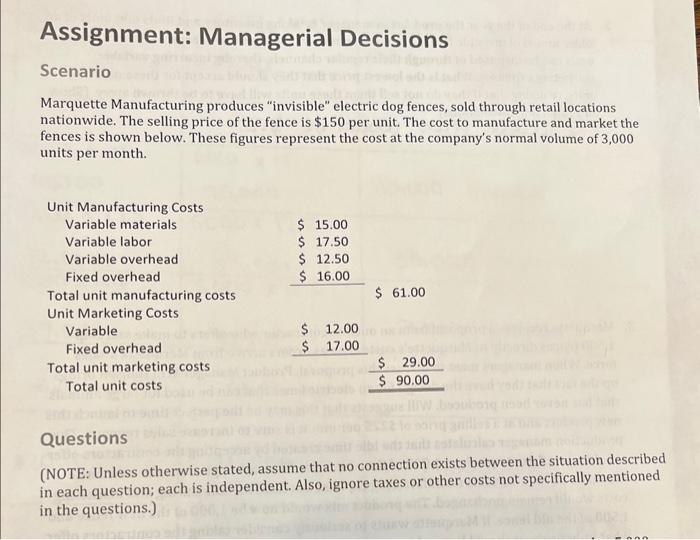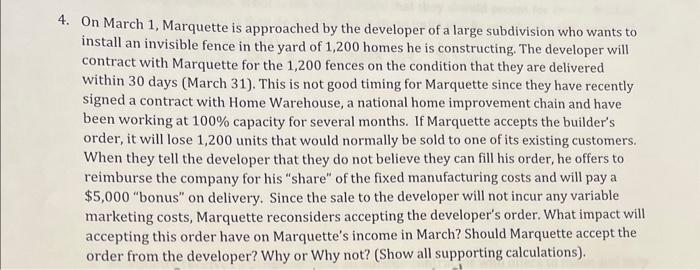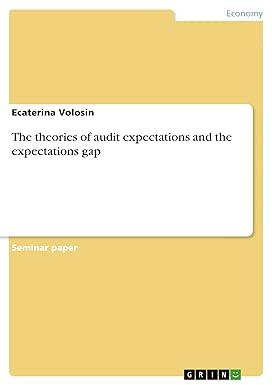please explain in detail!

Assignment: Managerial Decisions Scenario Marquette Manufacturing produces "invisible" electric dog fences, sold through retail locations nationwide. The selling price of the fence is $150 per unit. The cost to manufacture and market the fences is shown below. These figures represent the cost at the company's normal volume of 3,000 units per month. Questions (NOTE: Unless otherwise stated, assume that no connection exists between the situation described in each question; each is independent. Also, ignore taxes or other costs not specifically mentioned in the questions.) 3. Marquette receives a proposal from an outside contractor who offers to make and ship 1,500 fences directly to Marquette's customers as orders arrive from Marquette's sales force. When managers meet to discuss this proposal, Product Manager Will Hansen brings up the fact that they have the design for an electric fence that can be used for large animals that has never been produced. Will suggests that this may be the perfect time to launch this new product and at a selling price of $225 per unit it is sure to increase sales revenue. The production manager calculates that the idle time created by accepting the contractors offer would allow them to produce 1,000 of the new fence. The cost to produce the new fence would be $175 in variable manufacturing expense but fixed manufacturing and marketing costs would remain unchanged. The product mix would now be 1,000 of the new fence and 1,500 of the old fence. If Marquette wants to seriously consider taking the contractors offer, what in-house cost should be used to evaluate the outside contractor's bid. If the payment to the outside contractor is $90 per unit, should they accept the offer? Why or why not? (Show all supporting calculations). 4. On March 1, Marquette is approached by the developer of a large subdivision who wants to install an invisible fence in the yard of 1,200 homes he is constructing. The developer will contract with Marquette for the 1,200 fences on the condition that they are delivered within 30 days (March 31). This is not good timing for Marquette since they have recently signed a contract with Home Warehouse, a national home improvement chain and have been working at 100% capacity for several months. If Marquette accepts the builder's order, it will lose 1,200 units that would normally be sold to one of its existing customers. When they tell the developer that they do not believe they can fill his order, he offers to reimburse the company for his "share" of the fixed manufacturing costs and will pay a $5,000 "bonus" on delivery. Since the sale to the developer will not incur any variable marketing costs, Marquette reconsiders accepting the developer's order. What impact will accepting this order have on Marquette's income in March? Should Marquette accept the order from the developer? Why or Why not? (Show all supporting calculations). 5. Marquette has an opportunity to sell its product through an online retailer. To begin selling through this online platform, they are required to ship 2,000 units to the retailers' order fulfillment warehouse. The other condition of this offer is that they pay a one-time vendor marketing fee of $5,000. To get the units to the fulfillment warehouse by the deadline Marquette will need to pay for expedited shipping at a cost of $10 per unit. What is the minimum price Marquette should charge the retailer for this initial order of 2,000 units? (Show all supporting calculations). Assignment: Managerial Decisions Scenario Marquette Manufacturing produces "invisible" electric dog fences, sold through retail locations nationwide. The selling price of the fence is $150 per unit. The cost to manufacture and market the fences is shown below. These figures represent the cost at the company's normal volume of 3,000 units per month. Questions (NOTE: Unless otherwise stated, assume that no connection exists between the situation described in each question; each is independent. Also, ignore taxes or other costs not specifically mentioned in the questions.) 3. Marquette receives a proposal from an outside contractor who offers to make and ship 1,500 fences directly to Marquette's customers as orders arrive from Marquette's sales force. When managers meet to discuss this proposal, Product Manager Will Hansen brings up the fact that they have the design for an electric fence that can be used for large animals that has never been produced. Will suggests that this may be the perfect time to launch this new product and at a selling price of $225 per unit it is sure to increase sales revenue. The production manager calculates that the idle time created by accepting the contractors offer would allow them to produce 1,000 of the new fence. The cost to produce the new fence would be $175 in variable manufacturing expense but fixed manufacturing and marketing costs would remain unchanged. The product mix would now be 1,000 of the new fence and 1,500 of the old fence. If Marquette wants to seriously consider taking the contractors offer, what in-house cost should be used to evaluate the outside contractor's bid. If the payment to the outside contractor is $90 per unit, should they accept the offer? Why or why not? (Show all supporting calculations). 4. On March 1, Marquette is approached by the developer of a large subdivision who wants to install an invisible fence in the yard of 1,200 homes he is constructing. The developer will contract with Marquette for the 1,200 fences on the condition that they are delivered within 30 days (March 31). This is not good timing for Marquette since they have recently signed a contract with Home Warehouse, a national home improvement chain and have been working at 100% capacity for several months. If Marquette accepts the builder's order, it will lose 1,200 units that would normally be sold to one of its existing customers. When they tell the developer that they do not believe they can fill his order, he offers to reimburse the company for his "share" of the fixed manufacturing costs and will pay a $5,000 "bonus" on delivery. Since the sale to the developer will not incur any variable marketing costs, Marquette reconsiders accepting the developer's order. What impact will accepting this order have on Marquette's income in March? Should Marquette accept the order from the developer? Why or Why not? (Show all supporting calculations). 5. Marquette has an opportunity to sell its product through an online retailer. To begin selling through this online platform, they are required to ship 2,000 units to the retailers' order fulfillment warehouse. The other condition of this offer is that they pay a one-time vendor marketing fee of $5,000. To get the units to the fulfillment warehouse by the deadline Marquette will need to pay for expedited shipping at a cost of $10 per unit. What is the minimum price Marquette should charge the retailer for this initial order of 2,000 units? (Show all supporting calculations)











